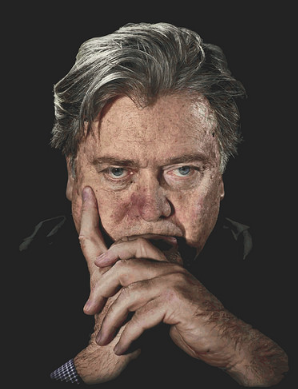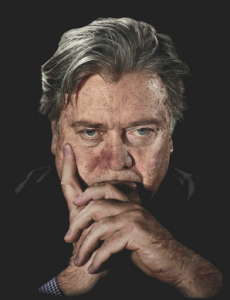The President Whisperer
 goo.gl/CPd869
goo.gl/CPd869
President Trump began his first two weeks in office by delivering a few of his top campaign promises, issuing executive orders calling for the “construction of a wall of undetermined type, length, and height along the southern border” with Mexico, as well as a ban prohibiting the entry to refugees and citizens from seven predominantly Muslim countries. The result: all hell broke loose.
With regard to both, the “bigoted undertones of Trump’s Mexico policy and the overtones of the ban” keep in line with the racial venom that permeated his presidential campaign. Worryingly, his pronouncements and the first acts as President seem to confirm a side to Mr. Trump that many thought or hoped would simply evaporate when he took the oath of office. Sadly, however, the logic of this new administration has been spelled out with arresting clarity: the comeback of white America under Trump.
Although his attention seems focused on creating havoc for those outside the U.S., domestically Trump won’t be taking any prisoners either. According to the Washington Post, his administration is devising a strategy on how to prevent all incoming immigrants and find a way to deport those already in the U.S. depending on the tax-payer aid they receive.
On the ideological front, the President wishes to redesign a state-government program which tackles all extreme ideologies and movements within the U.S. to shift its attention to solely on Islamist fundamentalism. This move will equally serve to divert attention away from white supremacists groups who have attacked the United States and present a long-standing domestic threat while hyper-inflating the role played by the Islamists. There is supporting evidence obtained from the intercept of a classified Counterterrorism Policy Guide that reveals the results of FBI’s investigative tracking of white supremacists, indicating that “extremists have infiltrated state and local law enforcement agencies”. This provides white supremacists the freedom to influence their cause from within the very institutions whose duty it is to prevent their spread. The report concluded that homegrown extremists harbouring violent white supremacist ideology are currently the most threatening source of terrorism to the United States, against what is portrayed in the media’s limelight. Additionally, Trump has vowed to allocate federal resources to inspect minority votes and aggressively tackle violence in Chicago.
Amidst the chaos, however, there is a growing presumption that the President was not alone in drawing up the executive order and it is pointing to Trump administration’s chief strategist Stephen Bannon, who according to Politico, has been crafting the orders with the help of Stephen Miller, another of Trump’s senior advisors. The Guardian reports that Bannon was the one who reportedly overruled the exemption of green-card holders and who by-passed the consultation by the Department of Homeland Security.

Meet Steve Bannon, the “ethno-nationalist former head of right-wing media outlet Breitbart” who is taking over the White House. On the day of the mass protests on the weekend following the President’s inauguration, #StopPresidentBannon flooded Twitter.
Since then, a growing anxiety has gripped the American public, concerned by the man who has been denounced for sympathizing with white-nationalist causes having become the President’s whisperer. Indeed, the gateway to influencing policy in the White House under any administration is by securing the seat beside the President as his most important adviser. However, as Paul Waldman states, the problem is not the position Bannon occupies, it’s what he wants to do with it. And what he wants to do is coax the President into envisioning his far-right political philosophy and bring it into practice. It seems Bannon has been pulling the strings from behind the curtains on a number of vital issues. To name a couple, he co-wrote the Jacksonian “America First” inaugural address, and was instrumental in the nomination of Senator Jeff Sessions for attorney general which was the first step in fulfilling Trump’s promise of a Muslim Ban. As stated in the words of Foreign Policy: “If there was any question about who is […] behind the scenes at the White House, the answer is […] Steve Bannon.”
Aside from the shared world-view, the two self-proclaimed politicians complement or rather complete each other. Since his debut, Trump has been consistent in two things: incoherency and inconsistency. In comes Bannon, providing a coherent political philosophy for the president’s scattered ideas. This is not to say that Trump hasn’t been the driving force of his own chauvinistic ideology; he has, but he is an instinctive politician and very flexible on some vital issues and so he ‘flip-flops.’ Over time, Trump has mastered the art of self-contradiction, shifting back and forth from one pole to another on matters of abortion, gay marriage, and even running for office. But he has also demonstrated unwavering determination in some of the other issues; for instance he’s long been a protectionist and foreign policy unilateralist. This protectionism reflects a traditional conservative style reconstructed in today’s alt-right.
Trump being a right-wing conservative is not the problem; the issue is his lack of familiarity with the conservative intellectual landscape that forms the backbone of his distorted convictions. From the beginning he distanced himself from the Republican party, and gained the distaste of conservative officials across the board, national security experts and Republican representatives alike. Without much concrete knowledge of or clear links to any prominent right-wing predecessors, Trump was in great need of a mentor, someone who could sew together all of his frameless, racist ideologies. Bannon’s influence comes from his ability to fill the voids in Trump’s vision.
Bannon is using Trump the way an employer makes use of a sales assistant to market a product, by investing his efforts in the person who can sell, regardless of how much they know about the actual product or how all the pieces fit together. Whereas Trump needs someone to articulate the images in his mind – to bring clarity to his own vision – Bannon needs someone with the power and personality to produce an audience, and to sell his product. After years of casting for the right vessel to bring forward his cause, Bannon was finally rewarded with Trump, a power-hungry ego-maniac, fearless in his vision and rhetoric.
But Donald Trump has other faults. His inability to stick to one theme at a time leads to distraction and jeopardizes his overall objective, whatever that may be. Bannon, however, who is “intelligent, articulate […] and dedicated to the struggle” can keep Trump’s rhetoric focused and intelligible, and above all, maintain its consistency. From the moment Bannon stepped in as the backstage manager, there has been a noticeable shift in Trump’s presentation style, putting an end to his shambolic campaign tirades in exchange for the more clear-cut ‘America First’ discourse. Bannon has been accused of being a ‘different creature’ altogether, a ‘crusader’ who envisions an America at war with its ‘enemies’ both within and outside of its borders. For his part, the President has not been shy to accredit his campaign and his Presidency more than a change in administration, rather a movement, in which someone like Bannon is needed to take his “rudimentary instincts and turn them into a coherent political philosophy”.
The Trump-Bannon presidential duet is an unholy marriage of dominance and subjugation where the President appears subservient to Bannon’s authority. The mere fact that there is doubt about who is controlling whom in the White House is troubling. It communicates the President’s vulnerabilities to hard-liners that he has placed in those very corridors, determined and unrelenting. As Lawrence Douglas from the Guardian writes, Bannon is not the President’s servant, the President is his instrument. All this time we’ve been fearing Trump, what about the man lurking in his shadow?
